
Drowning and Resuscitation Pages: 1 2 3 4 5 6 7 Next>>
Resuscitation of Drowning Victims at Sea, Page 3
An Overview of Resuscitation Techniques Used 1633 - 1764
There are a number of resources which explain how a person can be resuscitated in the time period immediately before, during and immediately after the golden age of piracy. Some of them deal with reviving the drowned while others explain what techniques were used for non-water asphyxiation such as hanging1 and air deprivation in mines2. Although the techniques for resuscitation are similar (even identical in many cases), we are going to focus on the books that explain how to revive the nearly drowned since it is most applicable to pirates and life at sea.
Period and Near-Period Books on Resuscitation of Drowning Victims
Resuscitation techniques for around the golden age of pirates 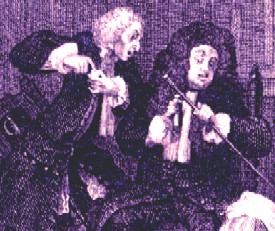
Artist: William Hogarth
"Expires While Doctors are Disputing", from
A Harlot's Progress
(1730)
in this article comes from six books from the period 1633 - 1773. These include: Stephen Bradwell's Helps For Suddain Accidents Endangering Life (1633); Henry Teonge's The Diary of Henry Teonge (1675); Johann Nicolas Pechlin's De Aeris et Alimentorum Defectu et Vita Sub Aquis, Meditatio. (1676); John Moyle's Chirurgius Marinus: Or, the Sea-Chirurgeon (1693); John Atkins' The Navy Surgeon (1742); and John Wilkinson's Tutamen Nauticum or The Seaman's Prevention from Shipwreck, Diseases and Other Calamities Incident to Mariners, London, (1764).
Using these books, I hope to present a picture of the progression of the techniques used to revive the nearly drowned from before the golden age of piracy up until the methods became more codified in the time period following it. (On this website I have defined the golden age of piracy as being from 1690-1725.)
Let's look a little closer at each book and author and get a bit of insight as to why I have chosen them..
Stephen Bradwell's Helps For Suddain Accidents Endangering Life (1633)
Stephen Bradwell was a
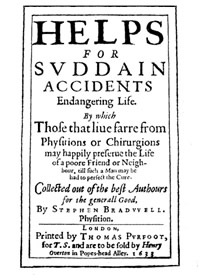
Title Page of Bradwell's Book
16th/17th century physician who was "frequently in trouble with, and prosecuted by, the College of Physicians in London and was thus not part of the capital's 'medical establishment'."3 He claimed to have started studying medicine sometime before 1585 without actually practicing it, for which he was ordered to desist by the College. He was again brought to the College in 1594 for charges of practising medicine in the previous four years. Bradwell claimed he "was 'a student of medicine'. His behavior was unassuming and his answers were not without learning."4 He was then fined and told he might apply for license, which he received in July of 1594.5
Helps for Suddain Accidents is believed to be the first English first aid manual in print. Bradwell's title page explains that the book is intended for "Those that live farre from Physitions or Chirurgions [so that they] may happily preserve the Life of a poore Friend or Neighbour, till such a Man [a surgeon] may be had to perfect the Cure."6 His book contains simple explanations for a wide variety of health crises including: animal bites, poisoning, and various types of asphyxiation.
This book is included because it it the first I have discovered which addresses the issue of drowning and it came out around the time John Woodall wrote the first English sea-surgeon's manual, the surgions mate. Woodall is strangely silent on the topic of resuscitation in all three editions of his book, so I am relying on Bradwell to provide insight into the techniques that Woodall may have employed, had he the opportunity.
Henry Teonge's The Diary of Henry Teonge (Written in 1675)
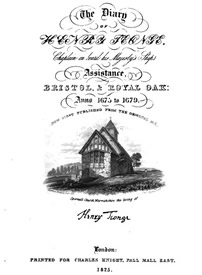
Title Page of Teonge's Book
Henry Teonge was a chaplain for the Royal Navy on a variety of ships between 1675 and 1679. In the preface to the first printed edition of his diary (published in 1825), publisher Charles Knight said that the seller of the diary thought it might "present a very natural and faithful picture of customs and manners, as they existed in the English Navy... and it further offered some very singular results of of the experience of an observing and intelligent mind, expressed often with peculiar force and humor"7.
Teonge was 55 years old when he decided to go to sea. The Dictionary of National Biography explains this decision. "In May 1675, being, it appears, in exceeding want, he obtained a warrant as chaplain on board the Assistance then in the Thames preparing for a voyage to the Mediterranean."8 He was married with three children at that time, which may help explain his desperate financial straights.
His journal is not rich in details on how to cure drowning save for one incident involving the delivery of an air enema by a sailor to a nearly drowned man. This dates the enema as a means of resuscitation at sea to before the golden age of piracy, which is my primary reason for including it.
Johann Nicolas Pechlin's De Aeris et Alimentorum Defectu et Vita Sub Aquis, Meditatio. (1676)
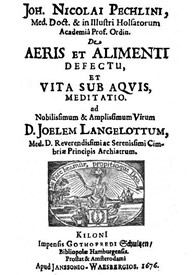
Title Page of Pechlin's Book
Johann Pechlin was a Dutch physician who received his doctorate in medicine in Leiden, Holland in 1667. Upon graduation he traveled around Italy on a "scientific journey", most likely to study medical practices. He become a professor at the University of Kiel in Germany in 1678, leaving in 1680 to become a "'Professor in absentia' and the personal physician of Duke Christian Albrecht of Holstein-Gottor, entitled Councilor after Gottorp Castle, at the same time he was prefect of the Gottorfer library."9
Pechlin was a prolific writer on diverse topics with many of his books going into multiple editions. All of his books were written in Latin, which was the language of physicians at this time in history. The book where he discusses resuscitation techniques, De Aeris et Alimentorum Defectu et Vita Sub Aquis, Meditatio. (roughly translated: Meditating on the Lack of Air and Food and Life Under the Water), was published in 1676.
While there were no reprintings of the book, it clearly had an impact on the medical community. His story of the resuscitation of the nearly drowned Gardener of Tronningholm is repeated in many other works, most notably (for our discussion) William Derham's Physico-theology which was first published in 1713.
John Moyle's Chirurgius Marinus: Or, the Sea-Chirurgeon (1693)
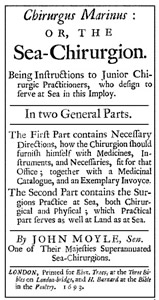
Title Page of Moyle's Book
John Moyle was a sea surgeon in the Royal Navy for many years, although his length of service is not entirely clear. He refers to service in the "'the last Holland War' in 1673"10 and he was retired in 169011, so we can say his term as surgeon at sea lasted at least 17 years, and likely more than that.
His first book, Abstractum Chirurgiae Marinae, or An Abstract of Sea Chirurgery was published in 1686. In the preface, he wrote, "But before my Exit I resolved to write this Abstract, according to what Skill and Experience I have attained for the use of others of my Calling, who are the true Sons of Escapius. and either are, or would be Sea-Chirurgeons"12. The book contained "Three Compendious Books"; the first relating to the duties of a sea surgeon, the second focusing on how he was to prepare for battle and treat various battle wounds and the last discussing day-to-day ailments the surgeon might encounter on a ship.
The material in this book was rewritten, re-organized and expanded into Moyle's sea surgeon manual Chirurgius Marinus, published

Author John Moyle
first in 1693 which was greatly expanded and republished in 1702. This makes it the only book that was actually published during the golden age of piracy.
The wonderful thing about Moyle's books is their workaday readability. This is not always found in other near period sea-surgeon-oriented books. In the 1702 edition, Moyle rather self-consciously explained his writing style "'tis my rural phrase or marine idiom, let your sublime generosity impute that to my less exornate dialect, let your eye be upon the matter of fact, which I can, without vanity, assert to be sound practical chyrurgery."13 The British Journal of Surgery explained "for John Moyle, senior, if he was not a good classic [classic surgeon - meaning he didn't rely on previous surgeons' and physicians' teachings], he was a capable and practical surgeon, devoid of imagination, and intent only on describing what should be done under the conditions of naval service to which he had been accustomed."14 What more could a modern student of ancient surgical practices ask for?
While the previous books had all provided detailed case studies on resuscitating the nearly drowned, Moyle's book is the first I found relating to the sea which gives an actual procedure for dealing with victims of water inhalation.
John Atkins' The Navy Surgeon (1732)
John Atkins was another naval surgeon who trained as a surgeon's apprentice, entering the navy as soon as he was certified. His book indicates that he began treating as early as 170315 when Atkins would have been 19 years old. Atkins
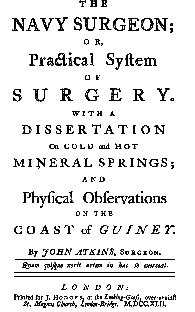
Title Page of Atkin's Book
served in several men-of-war and was surgeon during various battles during his career with the royal navy. He was also part of the crew of the Swallow and Weymouth, naval ships sent to roust pirates on the African coast in 1721. "They visited Sierra Leone, Wydah, the Gaboon, Elmina, and captured at Cape Lopez 270 pirates and 10,000l. in gold dust."16 The ships returned to England in 1723. Unable to be recruited on another ship, Atkins retired with 20 years of service and took to writing.
His first book, The Navy Surgeon, was published in 1732. It was to see 4 more editions following the first printing. One modern commentator noted the the writing in The Navy Surgeon "shows the author to have been an observant but somewhat prejudiced practitioner."17 Unlike Moyle, Atkins book tends to wander a bit, citing multiple other surgical authors in classical surgical author fashion. As such, his work tends to be somewhat derivative in nature.
Atkins provides a brief procedural on resuscitating a drowned man. It shares some features in common with Moyle's and may even have drawn upon that author's work given Atkins' penchant for assimilating information from other authors into his work and practice.
Although his book was published after the golden age of piracy, Atkins sea-based practice took place entirely within the time frame of the age, so his comments are of interest as a window into how at least one surgeon practised medicine during that time. He typically provides a variety of interesting cases from his practice at the end of a procedural description, although this is unfortunately not true for his chapter on drowning.
John Wilkinson's Tutamen Nauticum or The Seaman's Prevention from Shipwreck, Diseases and Other Calamities Incident to Mariners, London, (1764)
Little can be gleaned about the author from his book other than his being a medical doctor and having a great enthusiasm for the topic of life jackets as standard equipment for all Englishmen going to sea. 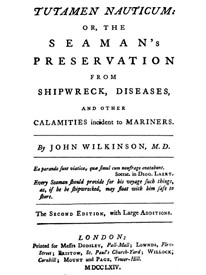
Title Page of Wilkinson's Book His publically professed excitement for the saving of seamen's lives began in 1758.
The author of [this book] having reflected a good deal, and with much concern upon the many lives that, as a naval and commercial people, were annually lost to this nation by shipwreck, and other like accidents, was emboldened, on the 4th day of January 1758, to present a memoir to this society [the Royal Society of Arts] recommending to their attention to consider some means for preventing those very frequent disasters; he thought such a step to be perfectly consistent with their plan, as instituted on principles totally national.18
This memoir was published two months later "after a certain person did me the honor to regard it in a light so much better than the orator"19.
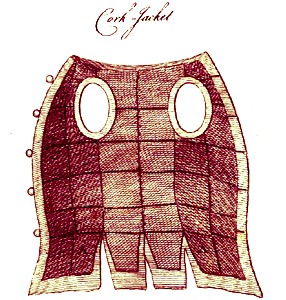
The Cork Life Jacket Proposed by John Wilkinson
From Tutamen Nauticum, p. 22
Sometime after that Wilkinson designed a cork life jacket "after several contrivances for this purpose [were] made, experienced, and rejected"20. He had the winning design patented in 1765.21 Although it is not entirely clear how he came up with his design, he admits to borrowing concepts from Machiavel's book Arte di Guerra22, which "proposed a floating girdle [to be filled with air] for conveying of soldiers over rivets with safety" as well as being inspired by a bamboo design used by Chinese merchants on a ship during a monsoon in 1730.23
Tutamen Nauticum was clearly written to promote his cork life jacket to the royal navy, hoping that they would see fit to supply every soldier with a cork life vest. Unfortunately, this design does not appear to have been adopted by them during Wilkinson's lifetime, although testimonial letters printed in the book suggest that these vests were for sale to individual sailors.
While its origins are interesting, the life vest is not of primary interest to us. It clearly came about long after the last golden age pirate had left the sea. What is of interest is a section in the beginning of his second book titled "Expedients for the Recovery of Persons supposed to be Drowned. In a Letter to Petere E.--n. Esq." written by Wilkinson. Here we find an extensive list of the various methods of resuscitating drowning victims with the sailor in mind. Wilkinson also provides some explanations as to why these methods may work which give insight into the medical theory at this time.
Resuscitation Techniques Suggested by Each Book
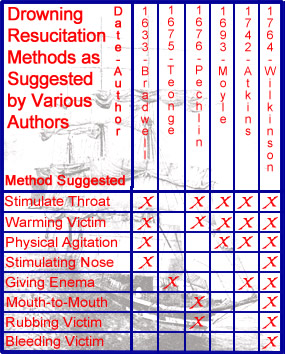
Resuscitation Techniques by Book
Background Image: Wreck of the Cromdale (1913 )
The purpose of detailing each book used in this section was to give some background on what material was used to create the chart at right. All of the books discussed could have been available to period surgeons with the exception of Atkins and Wilkinson. Since Atkins material drew upon period procedures, he is a useful proxy for what might have been done.
As the chart shows, each of the eight techniques discussed in Wilkinson's book was suggested by at least one author before him with a most curious exception: bleeding the victim.
Bloodletting was practiced in many situations with the notion that it would draw bad humors out of the body. However, period and near-period authors did not appear to see a connection between bleeding and resuscitation of an unconscious drowning victim, at least based on these books. Moyle does mention bleeding after the patient revived, but he does not suggest it while the victim is still unconscious like Wilkinson does.
This chart suggests that each of the techniques in it other than bloodletting was known and could therefore have potentially been tried by a sea surgeon trying to revive someone during the golden age of piracy.
It would be nice to have more complete information on what techniques were used to try and revive drowned sailors, but as we have already seen, most journals from the time tend only to mention when someone drowned, not when they were revived or how. Unfortunately, I've found only a few period drowning resuscitation case studies. Fortunately, a plethora of cases was compiled beginning in 1767 that may add to our understanding.
1 For example, see Richard Watkins, Newes from the Dead or A True and Exact Narration of the miraculous deliverance of Anne Greene, Oxford, 1651; 2 For example, see John Fothergill's Observations on a Case Published in the last Volume of the Medical Essays &c, giving the account of surgeon William Tossack resuscitating a miner by mouth-to-mouth in 1744; 3 Peter Elmer & Ole Peter Grell, Health, Disease and Society in Europe, 1500-1800: A Sourcebook, p. 152; 4,5 "Bredwell, Stephen (Sen), British History Online Website, gathered 2/13/14; 6 Stephen Bradwell, Helps For Suddain Accidents Endangering Life, title page; 7 Henry Teonge, The Diary of Henry Teonge, Chaplain on Board H.M.’s Ships Assistance, Bristol, and Royal Oak, 1675-1679, p. iii-iv; 8 John Knox Lauighton, "Teonge, Henry (DNB00)", Wikisource, gatjhered 2/13/14; 9 A. Hirsch: Johann Nicolas Pechlin In:. General German Biography (ADB). Volume 25, Duncker & Humblot, Leipzig 1887, pp. 306; 10 "John Moyle. One of Her Majesties Ancient Sea-Chirurgeons.", British Journal of Surgery, Vol. 3, Iss. 12, 1915, p 585; 10 John Knox Lauighton, "Moyle, John (d.1714) (DNB00)", Wikisource, gatjhered 2/14/14; 12 John Moyle, Abstractum Chirurgæ Marinæ, Epistle Dedicatory, p. 2-3 (not paginated); 13 John Moyle, cited in British Journal of Surgery, Vol. 3, Iss. 12, 1915, p 588;; 14 British Journal of Surgery, Vol. 3, Iss. 12, 1915, p 588;6; 15 See for example John Atkins, The Navy Surgeon, p. 142; 16, 17 Norman Moore, "Atkins, John (DNB001)", Wikisource, gatjhered 2/14/14; 18 John Wilkinson, Tutamen Nauticum or The Seaman's Prevention from Shipwreck, Diseases and Other Calamities Incident to Mariners, p. xiv; 19 Wilkinson, p. ii; 20 Wilkinson, p. 7; 21 "Early lifesavers – the cork lifejacket", National Maritime Museum, Cornwall Website, gathered 2/14/14; 22 Wilkinson, p. ii; 23 Wilkinson, p. iii

